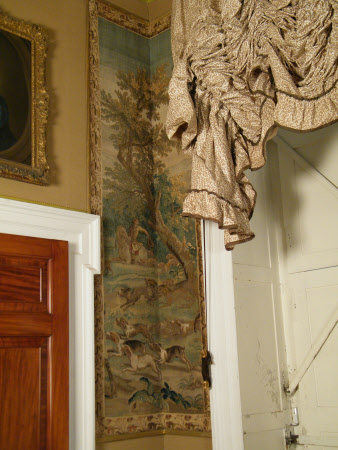The Chase (right side)
William Bradshaw (1700 - 1775)
Category
Tapestries
Date
circa 1730 - circa 1740
Materials
Tapestry, wool and silk
Measurements
2.64 m (H); 0.93 m (W)
Place of origin
Soho
Order this imageCollection
Clandon Park, Surrey
NT 1441618.4
Summary
[Destroyed in the fire of 2015] Tapestry, wool and silk, The Chase (right side) from a set of four Hunts, William Bradshaw after John Wootton, c. 1730-1740. In the right foreground two men on horseback gallop through the landscape from right to left, with a man on foot and hounds running ahead of them, chasing a hare. In the background there is an open landscape with a view to distant mountains. There is a narrow border on all four sides woven to imitate a carved and gilded frame with a running acanthus-leaf pattern. The tapestry would originally have formed the right hand section of a larger design of ‘The Chase’ incorporating two other pieces that now hang elsewhere in the same room, nos. 14441618.1 and 1441618.2.
Full description
The four tapestries in the Hunting Room at Clandon are based on a set of prints by Bernard Baron after John Wootton, but with the designs reversed. Three of the tapestries are sections from a single, large panel based on John Wootton’s design of ‘The Chase’, representing a hare hunt in progress, and show men and hounds running through a landscape. The fourth is based on Wootton’s print ‘The Hounds at Fault’ and shows the huntsmen waiting for the hounds to catch the scent. A set of Wootton’s prints hangs on the Wooden Stairs at Clandon, see no. 1441523. Although based on English prints, the ultimate inspiration for the series may have been French. They are stylistically and thematically very close to the ‘Chasses Nouvelles’, designed by Jean-Baptiste Oudry for the Beauvais manufactory and woven from 1727. A related tapestry, based on another print from the Wootton series of hunts, ‘The Death of the Hare’, is signed ‘Bradshaw / Stranover’ either side of a white shield bearing a red cross of Saint George (currently with Keshishian, London, and illustrated in Vigo-Sternberg 1971, pp. 48-9). This tapestry has a different border to the four at Clandon so must be part of a different weaving, but the entire group probably formed one series of designs. The signature ‘Bradshaw’ refers to William Bradshaw (1700-1775), the foremost tapestry producer in London from the early 1730s until his retirement in the mid-1750s. Bradshaw had workshops on the corner of Soho Square with back premises extending down the west side of Greek Street, and from here he ran a thriving business as an upholsterer, with tapestry making just one aspect of his activity (Beard, 1997; Beard, 2002; Sheppard, 1966; Wyld 2013 b). The name ‘Stranover’ is that of Tobias Stranover (1684-1755), a Hungarian artist specialising in flower painting who worked with Bradshaw in the early 1730s (Wyld 2013 b, p. 325). The fact that the ‘Hunts’ are in fact based on prints after John Wootton indicates that Stranover’s role was not that of designer but may have been that of cartoon painter, and possibly also business partner. The joint signature appears again but reversed (with Stranover’s name coming first) on one other known piece, a settee formerly at Belton House (private collection; see Beard 1997, pp. 153-4 and plates 176-7). The ‘Death of the Hare’ can be dated to between c. 1729, when Bradshaw is first recorded as a tapestry producer in London, and 1732, when he and Stranover parted company. In the absence of a signature it is hard to be so precise in dating the Clandon ‘Hunts’, however a date between c. 1730 and 1740 is probable, and the set is most likely to date from the first half of the 1730s. In the late 1730s Bradshaw began producing a new set of designs of pastoral subjects based on prints after Watteau, Lancret and Pater, and these seem to have dominated his tapestry production from that point onwards. A set of four ‘Pastorals’ signed by Bradshaw is in the National Trust’s collection at Ham House (no. 1139884; see also Wyld 2013 b). A tapestry based on another print from the Wootton series, ‘The Going Out in the Morning’, sold at Christie’s, 26 June 1924, lot 134. It was paired with another tapestry whose description closely matched ‘The Death of the Hare’ (lot 135). Both had narrow borders similar to those at Clandon. (Helen Wyld, 2013)
Provenance
Purchased by the Ministry of Public Building and Works in 1963 from the 6th Earl of Onslow, transferred to the National Trust in 1977
Makers and roles
William Bradshaw (1700 - 1775), workshop after John Wootton (Snitterfield c.1682 – London 1764), designer
References
Wyld, 2013 b: Helen Wyld, 'William Bradshaw's Tapestries after Watteau', in Christopher Rowell (ed.), Ham House: 400 Years of Collecting and Patronage, New Haven and London 2013, pp. 325-336 Beard, 2002: Geoffrey Beard, ‘William Bradshaw: furniture maker and tapestry weaver’, Metropolitan Museum Journal, vol. 37, 2002, pp. 167-169 Beard, 1997: Geoffrey Beard. Upholsterers and interior furnishing in England, 1530-1840. Bard studies in the decorative arts. New Haven; London: Yale University Press, 1997. Hefford, 1984: Wendy Hefford, 'Soho and Spitalfields: little-known Huguenot tapestry-weavers in and around London, 1680-1780', Proceedings of the Huguenot Society of London, vol. XXIV, no. 2 (1984), pp. 103-112 Vigo Sternberg, 1971: Four Hundred Years of English Tapestries on Exhibition at the Vigo-Sternberg Galleries, London 1971 Sheppard, 1966: 'Appendix I: The Soho Tapestry Makers', in F H W Sheppard (General editor), Survey of London: vols. XXXIV-XXXV, The Parish of St Anne Soho, London 1966, pp. 515-520
